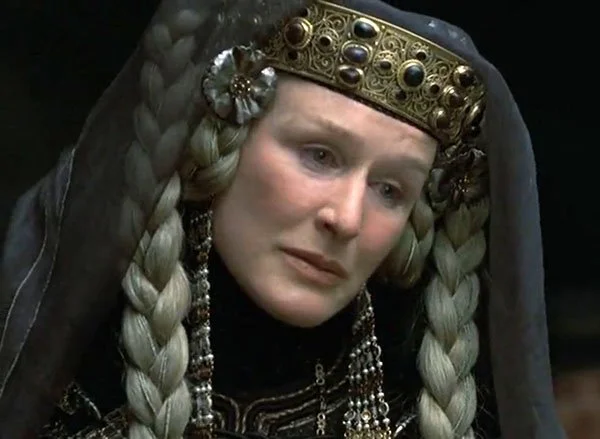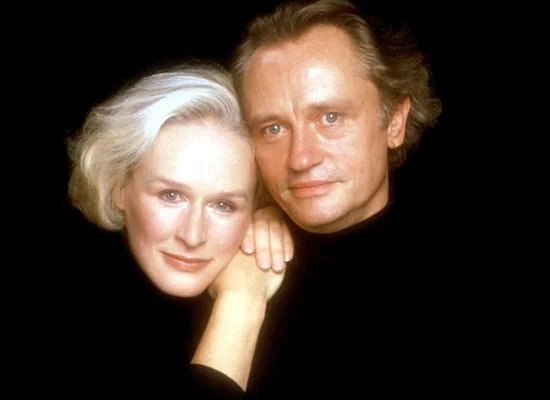Coaching Glenn Close: From Dangerous Liaisons to Tehran
It has been the honor of a lifetime coaching Glenn Close. It would be the first time Glenn Close would act in a language other than English and I was thrilled to be a part of this process, a rare gift I will cherish and celebrate for a long time to come. It was also a dream come true, because Glenn Close has been a poignant part of my personal life’s journey from a teenager in revolutionary Iran to my life as an adult living in California and working in theatre and film.
Glenn Close in Dangerous Liaisons (1988)
How Glenn Close became my idol
I will never forget the year when Glenn Close was nominated for an Oscar for best actress as Marquise de Merteuil in Dangerous Liaisons. It was 1989 and the clip the Academy had chosen was the one in which the Marquise, alone in the dead of night, starts removing her makeup while soaking in her desperate loneliness; her eyes windows to her soul, the mirror through which we understand the depths of the human psyche (and her ultimate downfall); the closeup sequence a must-see for anyone wishing for a masterclass in acting.
I must have watched that clip hundreds of times, my impressionable teenage persona adoring that remarkably beautiful and expressive face, and the young drama student in me also realizing what masters mean by “under-the-skin” or “through-the-eyes” acting.
And I have cherished everything Glenn Close since.
It was 1984 when my mother and I landed back in Tehran a decade after we had left it behind for sunny, carefree, post-Franco Spain. Barcelona was a second home of sorts for my father who was also returning from California. A revolution had materialized in our absence and we were about to enter a dark reality in which foreign films, music, all aspects of pop culture including the ability to be young through rebellious fashion trends, were strictly forbidden. When we had left Iran in the mid- 1970s, it was, at least on the surface, on its way to becoming a modern and prosperous European-like country. Now, it was a den of darkness, war and uncertainty; unrecognizable in every aspect.
We started reconstructing our lives by focusing on what we could change: our existence indoors. With an actor-filmmaker father (and a fashionista mother who readily subscribed to our passion for anything acting-related), we breathed film, talked about film, critiqued and exchanged them, and took pride in recognizing European and American actors in their various chameleonic roles.
A few years into the revolution, people started learning the intricacies of balancing an underground lifestyle —to continue being themselves— and an outer persona that conformed to the strict rules of conduct mandated by the new regime. Farhad was our trusted video rental guy; the one who would risk his neck carrying pirated films, in his triple-locked metal briefcase —including the latest blockbusters. It was he who brought us the magnificent Glenn Close performances like those in films such as George Roy Hill’s The World According to Garp (1982), Lawrence Kasdan’s The Big Chill (1983), Adrian Lyne’s Fatal Attraction (1987), Stephen Frears’ Dangerous Liaisons (1988), István Szabó’s Meeting Venus (1991) and Mel Gibson’s Hamlet (1990), not necessarily in that order. And with every new role, my respect for Glenn’s craft and expressive eyes grew knowing that she was an example of the type of actress I wanted to become.
Glenn Close in Hamlet (dir. Mel Gibson, 1990)
How I got to coach Glenn Close
It was a little over a year since the pandemic had sent us to our micro-bubbles, working remotely and accomplishing almost every duty online; our screens our miniature TV channels through which we broadcast our skills and communicated with the world. We were feeling weary and I was finding fuel in my creative work. It was also spring and a family of house finches had nested above our doorstep. “How fortuitous”, we thought when their singing attracted our attention and when we found out they are known to be symbols of positive change and good omens. Then, on a Tuesday morning, I woke up to a message about the opportunity for Persian language coaching for an Apple TV+ series. Our meetings started right away, but it wasn’t until after we decided to work together that I learned who I would be teaching.
“Glenn Close? The Glenn Close? The one whose unforgettable chameleonic characters I have been studying and following since my teens? The one I have been doting on from afar from Iran, Spain, England and the US and anywhere in between on airplanes, wherever I have lived?” I kept thinking of all the times and places in my life that I had already met Glenn Close. Then came the fireworks of excitement and, as soon as we met, Glenn’s authenticity, comfortable in her own skin, kind, humble, open, sincere, natural, and as lovable as you would wish your idol to be in real life, put me at ease instantly. And that is how we began a marvelous journey of linguistic discovery and collaboration to shape her next character.
The initial concert of butterflies I nursed at the thought of engaging creatively with my idol soon turned into the anticipatory joy of going to the encounter of the beloved. Much like stepping on a theatre stage, the moment our sessions started, the spotlights were on, and my priority was to ensure Glenn had everything she needed, that she felt comfortable with the language and that our approach to the new string of sounds that created meaning was seamless and somewhat ‘demystified’. Watching the result on screen now, I could not be more proud of Glenn’s work. The result is our belief in her character: that she has been speaking Persian for four decades in her adopted country; that the sounds flow together and that she knows what she is saying.
Glenn Close and Niels Arestrup in Meeting Venus (dir. István Szabó, 1991)
Acting in a different language
One of the beauties of coaching languages and dialects is the common language that is organically developed between coach and actor depending on the learner’s past linguistic experience. This is also true of the type of transliteration that is developed and agreed upon together. Some might be more comfortable with a double ‘o’ for the sound /u/ and, for those who come from a Francophone background, that would be ‘ou’ (this is why there are variations to the transliteration of the word for ‘day’: rooz, ruz, rouz and therefore norooz, noruz and norouz for ‘new day’ to mark the Persian new year at the onset of Spring).
During our weekly meetings, before working on the lines, we started building a foundation in the language so that Glenn would become familiar with certain sounds and also recognize the Indo-European nature of Persian (as evident by, for instance, family vocabulary such as mādar for ‘mother’, pedar for ‘father’, barādar for ‘brother’, xāhar for ‘sister’, etc. or other words such as shekar for ‘sugar’ or esfenāj for ‘spinach’, behtar for ‘better’ and so on). An added bonus was Glenn’s familiarity with French, which gave us the common reference to the distinction between forms of address, tu for informal and vous for formal (thee and thou in Middle English), to and shomā in Persian, and such expressions as the French je vous en prie for xāhesh mikonam or bitte schön in German.
The communicative teaching pedagogy, the backbone of my teaching practice over the past three decades, ensured Glenn would start communicating in Persian since day one. Greetings and talking about family, physical description, feelings, joining parts of speech and recognizing them exposed her to common words that we soon found on the script as well, making every rediscovery a celebratory joyous moment. Then came the melodic work on pronunciation: word stress and intonation in dialogues that I wrote for her character in relation to other characters she comes in contact with to incorporate cultural elements of tārof (polite forms of daily interactions such as “after you”, “but of course”, “I beg of you”, etc.).
Even though we had initially opted for a British-accented Persian, we soon realized and agreed on the priority of building a strong foundation, knowing that layers could be superimposed once the linguistic groundwork was solid. Ultimately, we decided to adhere to authenticity and believability.
Glenn’s background in singing, including in opera as seen in the film Meeting Venus, her familiarity with French (the sound /ʒ/ prominent in French and Persian only heard in a number of English words such as ‘azure’, ‘visual’, ‘casual’, ‘Persian’, etc.) and her infinite talent helped tremendously in the process of language acquisition so that she could make the dialogue her own and act in a new language for the first time in her career.
By the time we received the scripts and started focusing on the actual lines, not only was Glenn ready to roll unfamiliar sounds in her mouth and even identify some words, but we also had the freedom to try different variations and have her choose the one with which she felt most comfortable (i.e. man ham hamintor vs. beh hamchenin for ‘me, too/likewise’ or chetor-i? vs. xub-i? for ‘how are you?/are you well’?).
Approaching a new language while acting is heavy lifting; it requires daily practice and the belief that you can make the language your own from a place of awareness: knowing what you are saying, why, to whom and when. This, together with knowledge of stress and intonational patterns and cultural differences in body language will result in the type of ease in diction that results in the audience believing the character being portrayed as exemplified in Glenn’s subtle and credible performance in the Emmy-award winning series Tehran, S2. This is the first time we see the legendary Glenn Close speak a language other than English on camera and I could not be more thrilled to be associated with this exciting fact.
Looking back on my own coming-of-age story, learning Persian as a new language, reinventing myself and coming to terms with my multilingual and multicultural identity, surviving through political unrest and displacement, working hard at drama school to help me stay aflot during tumultuous times of social change —I can’t help but think of how overcoming major roadblocks in life have become the very cobble stones that have lead me on the path to the sweet rewards of the here and now. I feel gratitude for the gift of having spent quality creative time with Glenn Close. For me, there is a before and after Glenn Close; a timeline directly linked to my journey and the various stages of her presence in my life. First in films in the 1980s, then in person during a joy-filled creative collaboration that came at a perfect moment during a spring-summer of 2021.


